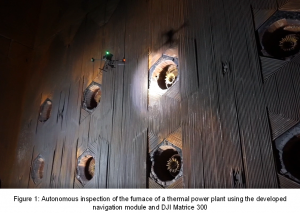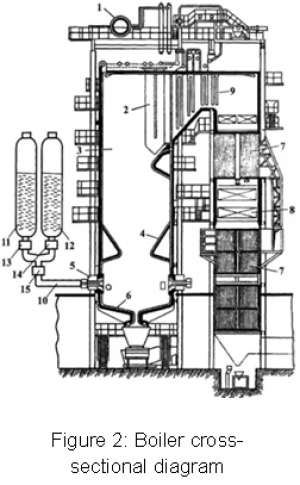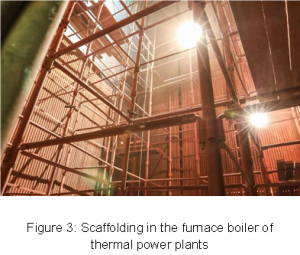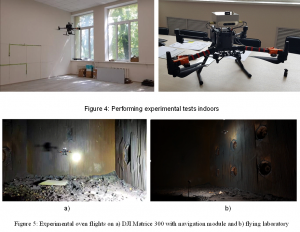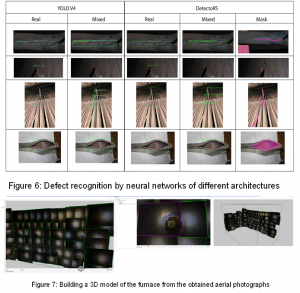Cincinnati, Ohio Sep 12, 2023 (Issuewire.com) - Autonomous inspection of furnaces of thermal power plants in 3 hours
Custom Drone Solutions LLC is a team inspired by drone solutions in GPS-denied environments. We create solutions with drones for industrial site inspections (https://customdronesolution.com).
The project
The main unit of a thermal power plant for generating electricity and heat is the furnace, which provides steam under high pressure, which is transferred through pipes and other auxiliary equipment to the turbine generator, making its blades rotate and generating electricity. The generated electricity is transferred to a transformer and distributed via transmission lines to consumers. The furnace is usually a parallelepiped 26 by 80 feet with a height of up to 300 feet, in some configurations there may be protrusions of screen sections (point 4 in Fig. 2) to provide the required aerodynamics of the gasses in the furnace.
Currently, the inspection of pipes in the furnace is performed by engineers using scaffolding (Fig. 3). Scaffolding construction takes a few days, taking into account the dimensions of the technological hole 20*40 inches, through which the whole structure has to be moved into the furnace. The inspection process itself takes a few days and in the end, the whole work will take more than a week. Under the above conditions, using a drone for autonomous overflight and collecting photo images of the furnace heating surfaces is an effective solution that will also eliminate high-rise work and improve its safety.
Autonomous inspection of the furnace by a drone will make it possible to fly over the entire surface of the furnace in 3 hours and take photos of the whole heating surface of the furnace (Fig.1). trained neural networks will allow you to recognize and highlight the places with defects in a short time. As a result, the defect detection of boiler tubes with the use of a drone can be carried out in one working day.
Significance of the project's contribution:
This complex makes it possible to speed up the inspection from several days to 3 hours and minimize the risks of human factors. Additionally, it should be noted that stopping the furnace operation is critical for the power generation of thermal power plants, so reducing the inspection time improves the efficiency of thermal power plants and enhances the energy security of the country.
The research conducted, including patent searches, showed that there are no solutions for аutonomous inspection of furnaces of thermal power plants. During the development of the system, we solved the following technological barriers: drone navigation in closed space in the absence of a GPS signal, drone flights in difficult conditions (heavy dust and lack of lighting), the presence of interference on the magnetic compass and magnetometer, the presence of error in height measurement by bar altimeter due to the presence of thrust, the lack of the required volume and quality of datasets of pipes with defects to train neural networks for their recognition.
The development of an industrial drone for autonomous monitoring of thermal power plant furnaces and recognizing defects in heating surfaces offers several important contributions to the industry:
- Improved health and safety: furnaces in thermal power plants can be hazardous environments due to high temperatures and potential exposure to harmful gasses. Using an autonomous drone for monitoring eliminates the need for human operators to be present in these hazardous areas, reducing the risk of accidents and increasing the safety of plant personnel.
- Early diagnosis of defects: The autonomous monitoring capabilities of the drone allow for frequent and regular inspections of the furnace and heating surfaces. By identifying defects such as cracks, corrosion, and erosion at an early stage, thermal power plants can address problems before they escalate, minimizing downtime and costly repairs.
- Increased efficiency: An autonomous drone can efficiently navigate around the furnace and heating surfaces, acquiring detailed thermal and visual data. This data provides valuable information about the condition of the equipment, allowing maintenance professionals to prioritize and effectively schedule repairs.
- Cost savings: Autonomous drone monitoring helps optimize inspection processes, reducing the need for manual inspections and associated labor costs. In addition, early detection of defects and timely maintenance prevent expensive equipment failures and unplanned downtime, resulting in cost savings for the power plant.
- Predictive analytics: Data collected by the drone can be integrated into predictive analytics systems. Machine learning algorithms can be applied to the data to predict potential defects or wear patterns, enabling proactive maintenance planning and further minimizing downtime.
- Energy efficiency: Through early detection of defects in heating surfaces, the power plant can maintain optimal combustion efficiency, resulting in reduced fuel consumption and greenhouse gas emissions.
- Regulatory compliance: Regular and comprehensive monitoring of furnace heating surfaces helps power plants comply with industry regulations and safety standards, ensuring that equipment is operating as specified.
- Reputation and reliability. Adopting advanced monitoring technologies demonstrates a commitment to continuous improvement and innovation in the industry. This can enhance a power plant's reputation for reliability and excellence, attracting investors and stakeholders.
- Transferable technology: The technology developed for standalone monitoring of thermal power plant furnaces may have wider applications in other industries involving high temperatures and hazardous environments. This transfer capability extends the potential impact of the technology beyond the energy sector.
In summary, the development of an industrial drone for autonomous monitoring of thermal power plant furnaces and detection of heating surface defects contributes to improved safety, efficiency, cost savings, and environmental performance. It enables power plant engineers to make data-driven decisions and ensure the reliable and sustainable operation of critical equipment.
Current status of the project:
1) Developed a navigation module for the DJI Matrice 300 industrial drone with additional sensors for autonomous flight in a furnace (Fig. 4). The navigation module provides the following functionality (Fig. 5):
- Automatic takeoff and landing
- Flight route along the wall
- Auto calibration during flight
- Automatic landing and flight continuation in case of battery discharge
- Obstacle avoidance ( protrusion)
2) Trained neural networks for recognizing defects (Fig. 6)
3) Developed a ground computing station to control the process and perform defect recognition (Fig. 7).
Media Contact
CUSTOM DRONE SOLUTIONS LLC info@customdronesolution.com 941 400 9260 5543 Ashton Way, Sarasota, FL 34231 https://customdronesolution.com
